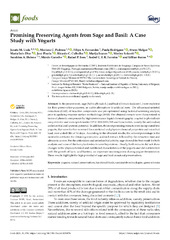Приказ основних података о документу
Promising Preserving Agents from Sage and Basil: A Case Study with Yogurts
| dc.creator | Ueda, Jonata M. | |
| dc.creator | Pedrosa, Mariana C. | |
| dc.creator | Fernandes, Filipa A. | |
| dc.creator | Rodrigues, Paula | |
| dc.creator | Melgar, Bruno | |
| dc.creator | Dias, Maria Inês | |
| dc.creator | Pinela, José | |
| dc.creator | Calhelha, Ricardo C. | |
| dc.creator | Ivanov, Marija | |
| dc.creator | Soković, Marina | |
| dc.creator | Heleno, Sandrina A. | |
| dc.creator | Carocho, Márcio | |
| dc.creator | Ineu, Rafael P. | |
| dc.creator | Ferreira, Isabel C. F. R. | |
| dc.creator | Barros, Lillian | |
| dc.date.accessioned | 2021-04-27T10:32:29Z | |
| dc.date.available | 2021-04-27T10:32:29Z | |
| dc.date.issued | 2021 | |
| dc.identifier.issn | 2304-8158 | |
| dc.identifier.uri | https://www.mdpi.com/2304-8158/10/3/676 | |
| dc.identifier.uri | https://radar.ibiss.bg.ac.rs/handle/123456789/4211 | |
| dc.description.abstract | In the present work, sage (Salvia officinalis L.) and basil (Ocimum basilicum L.) were exploited for their preservative purposes, as viable alternatives to artificial ones. The ultrasound-assisted extraction (UAE) of bioactive compounds was pre-optimized using factorial screening analysis, prior to applying response surface methodology (RSM). The obtained extracts were characterized in terms of phenolic compounds by high-performance liquid chromatography coupled to photodiode array detector and mass spectrometer HPLC-DAD-ESI/MS and bioactivities, namely the antioxidant, antimicrobial and cytotoxic potential. In addition, the most promising extracts were incorporated into yogurts, that were further screened for nutritional and physico-chemical properties and microbial load, over a shelf life of 14 days. According to the obtained results, the solvent percentage is the most relevant factor for obtaining rosmarinic acid-rich extract, followed by the extraction time and ultrasonic power. For the antioxidant and antimicrobial activity, sage showed the best result for both analysis and none of the two plant extracts were hepatotoxic. Finally, both extracts did not show changes in the physicochemical and nutritional characteristics of the yogurts and did not interfere with the growth of lactic acid bacteria, an important microorganism during yogurt fermentation. These results highlight the high potential of sage and basil as natural preservatives. | |
| dc.publisher | MDPI AG | |
| dc.relation | info:eu-repo/grantAgreement/MESTD/inst-2020/200007/RS// | |
| dc.rights | openAccess | |
| dc.rights.uri | https://creativecommons.org/licenses/by/4.0/ | |
| dc.source | Foods | |
| dc.subject | Functional foods | |
| dc.subject | Green solvents | |
| dc.subject | Natural preservatives | |
| dc.subject | Sustainable technologies | |
| dc.subject | Yogurts | |
| dc.title | Promising Preserving Agents from Sage and Basil: A Case Study with Yogurts | |
| dc.type | article | en |
| dc.rights.license | BY | |
| dcterms.abstract | Ферреира, Исабел Ц. Ф. Р.; Уеда, Јоната М.; Педроса, Мариана Ц.; Родригуес, Паула; Мелгар, Бруно; Диас, Мариа Инêс; Пинела, Јосé; Цалхелха, Рицардо Ц.; Иванов, Марија; Соковић, Марина; Хелено, Сандрина A.; Цароцхо, Мáрцио; Фернандес, Филипа A.; Инеу, Рафаел П.; Баррос, Лиллиан; | |
| dc.rights.holder | © 2021 by the authors. Licensee MDPI, Basel, Switzerland. | |
| dc.citation.issue | 3 | |
| dc.citation.volume | 10 | |
| dc.identifier.doi | 10.3390/foods10030676 | |
| dc.identifier.pmid | 33810113 | |
| dc.identifier.scopus | 2-s2.0-85103839530 | |
| dc.identifier.wos | 000633641600001 | |
| dc.citation.apa | Ueda, J. M., Pedrosa, M. C., Fernandes, F. A., Rodrigues, P., Melgar, B., Dias, M. I., et al. (2021). Promising Preserving Agents from Sage and Basil: A Case Study with Yogurts. Foods, 10(3), 676. | |
| dc.citation.vancouver | Ueda JM, Pedrosa MC, Fernandes FA, Rodrigues P, Melgar B, Dias MI, Pinela J, Calhelha RC, Ivanov M, Soković M, Heleno SA, Carocho M, Ineu RP, Ferreira ICFR, Barros L. Promising Preserving Agents from Sage and Basil: A Case Study with Yogurts. Foods. 2021;10(3):676. | |
| dc.citation.spage | 676 | |
| dc.type.version | publishedVersion | |
| dc.identifier.fulltext | https://radar.ibiss.bg.ac.rs/bitstream/id/8422/foods-10-00676-v2.pdf | |
| dc.citation.rank | M21 |

